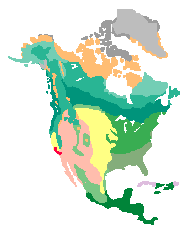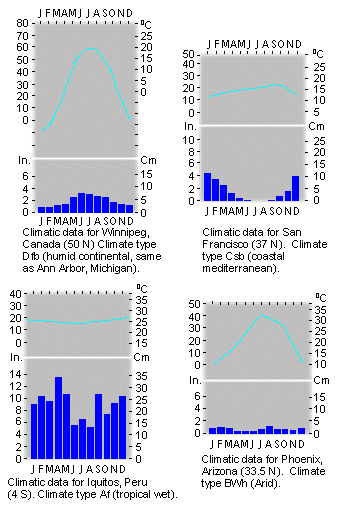Climate Patterns Past and Present
"Hark! The faint bells of the sunken city
Peal once more their wonted evening chime!
From the deep abysses floats a ditty
Wild and wondrous, of the olden time".
- Wilhelm Mueller, "The Sunken City", translation from
the German
We wish to learn:
- What do we mean by "paleoclimate"?
- What evidence exists for ancient climate change?
- What is the evidence for recent temperature change?
|
Introduction
To Global Change I Lecture Notes |
|
|||
| Paleoclimates | Current Climate | Summary | ||
1. Paleoclimates
|
|
From abundant geological evidence, we know that only three hundred and fifty years ago, the world was in the depths of a prolonged cold spell called the "Little Ice Age," which lingered for nearly 500 years. Fifty thousand years ago, in the middle of the last glacial period, large continental ice sheets covered much of North America, Northern Europe, and Northern Asia. Fifty million years ago, global temperatures were so high that there were no large ice sheets at all.
The speed at which climate can change has also recently become clear: Transitions between fundamentally different climates can occur within only decades. In order to understand these variations, we need to reconstruct them over a wide range of temporal and geographical scales. The importance of this task is underlined by the growing awareness of how profoundly human activity is affecting climate. As with so many other complex systems, the key to predicting the future lies in understanding the past
We need to ask several questions: What happened? Why did it happen? Has it happened before? Will is happen again? How do we know about it in the first place? Click the image to the right to explore the hypothesized changes in ice cover and vegetation.
Paleoclimatology
|
Related readings:
|
| University of Michigan students can access this Science On-Line article through this link. |
This is the study of past climates. It is a fascinating, multidisciplinary field, combining history, anthropology, archaeology, chemistry, physics, geology, atmospheric, and ocean sciences. Clues about past climate conditions are obtained from proxy indicators, types of evidence that can be used to infer climate. These include:
- Isotopic Geochemical Studies: The study of rock isotopic ratios,
ice core bubbles, etc.
- Dendochronology: the study of tree rings
- Pollen Distribution: the study of plant types and prevalence
- Lake Varves: (like dendochronology, but with lake sediments)
- Coral Bed Rings
- Fossils: Studies of geological settings, etc.
- Historical documents, paintings, etc.
Isotope Geochemistry
The most important of these for the study of long term change involves isotope geochemistry. We have already discussed the importance of isotopes for rock dating purposes; the carbon14 radiometric technique, for example, can date as far back as 60,000 years. However, there is another important use of isotopic ratio measurements using oxygen that is not dependent on radioactivity, but rather on the interaction between life processes and isotopes.
Oxygen is composed of 8 protons, and its most common form as 8 neutrons, giving it an atomic weight of 16 (O16) and is also known a "light" oxygen. A small fraction of oxygen atoms have 2 extra neutrons and a resulting atomic weight of 18 (O18), known as "heavy" oxygen. O18, is a rare form, with about 1 in 500 atoms of O being heavy.
The ratio of these two oxygen isotopes has changed over the ages and these changes are a proxy to changing climate in two ways:
Climate Temperature from Ice Cores
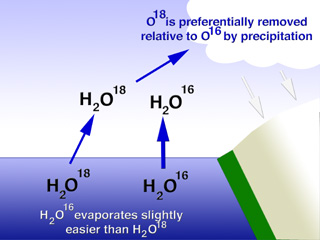 |
| Figure 2. Light oxygen in water (H2O16)
evaporates more readily that water with heavy oxygen (H2O18).
Hence oceans will be relatively rich in O18 when glaciers grow
and hold the precipitated O16. |
Ice in glaciers has an increased proportional abundance of heavy oxygen if it was deposited during relatively warm periods. To understand why this might be so, we need to think about the process of glacier formation. The water-ice in glaciers originally came from the oceans as vapor, later falling as snow and becoming compacted in ice. When water evaporates, the heavy water (H2O18) is left behind and the water vapor is enriched in light water (H2O16). This is simply because it is harder for the heavier molecules to overcome the barriers to evaporation. Thus, glaciers are relatively enhanced in O16, while the oceans are relatively enriched in O18. This imbalance is more marked for colder climates than for warmer climates. In fact, it has been shown that a decrease of one part per million O18 in ice reflects a 1.5°C drop in air temperature at the time it originally evaporated from the oceans.
While there are complexities with the analysis, a simple measurement of the isotopic ratio of O18 in ice cores can be directly related to climate. Ice cores from Greenland are layered, and the layers can be counted to determine age. The heavy oxygen ratio can then be used as a thermometer of old climate.
Climate Temperatures from Ocean Sediments
Shells of dead marine organisms are made up of calcium carbonate (CaCO3). The oxygen in the carbonate reflects the isotopic abundance in the shallow waters where the creatures lived. Thus if we can find and date ever more ancient sediments made up of old sea shells, we can determine the isotopic ratio of oxygen and infer the sea surface temperature at that time. The more O18 found in the sediment, the colder the climate (inverse relationship to that of glacier ice).
Many ice cores and sediment cores have been drilled in Greenland, Antarctica and around the world's oceans. These cores are actively studied for information on variations in Earth's climate. A summary of the results of isotopic geochemistry is available here.
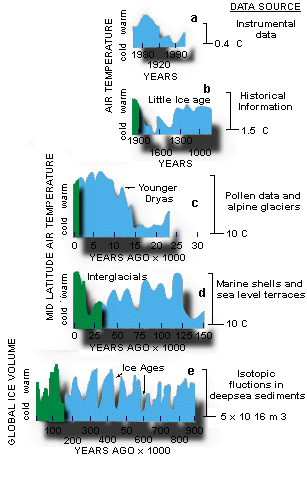 Figure 3. Changes in temperature as deduced using a number of paleoclimate techniques, each representing different time periods and/or regions. |
Figure 3 summarizes the climate record as presently understood and lists some of the techniques used for the measurement.
The most commonly used indicators include pollen, faunal and floral remains, sediment types or composition and geomorphological features indicating physical conditions. In the ocean, indicators such as microplankton, pollen, and sediments settle to the sea floor, where they accumulate to provide a nearly continuous record of climate for millions of years.
The bottom panel shows the record for the last million years. Each successively higher panel expands the shaded part of the panel immediately below. The top panel summarizes the last century.
Animations of the Temperature Record from 1856 to 1997 are available to explore spatial trends in temperature.
Limitations in Reconstructing Paleoclimates
The limitations in this process result from uncertainties associated with dating the proxy indicators or other evidence. There are two fundamental types of dating:
- Absolute dating
Techniques that identify the actual geological time represented by the evidence. Techniques are limited and rely predominately on evaluating the amount of decay of naturally occurring radioactive isotopes.
- Relative dating
Techniques that are able to differentiate time relative to other points in time. Stratigraphy establishes a relative sequence of events or characteristics within which the evidence lies. If this same sequence can be identified in multiple locations it can be used to establish the relationship between locations and the relative timing of the indicators.
2. Current Climate
Climate differs from weather in that it provides a statistical view of seasonal and daily weather events over a long term period. Thus, for example, the passage of a frontal system over Ann Arbor is weather event, while the daily average number of such passages for the month of July (averaged over several years) is part of the climate record.
Climate records are most often expressed in terms of temperatures, winds, precipitation, and pressures - all parameters that can be measured at multiple sites around the globe. Over the years a large data base of weather event measurements has been obtained, leading to a good description of today's climate.
We find that climate varies widely around the globe - we have deserts and rain forests, ice caps and "death valleys". As for most subjects discussed in this course, there is a taxonomy of sub-disciplines and we can speak of the following:
- Microclimate: climate conditions near the surface over distances
of a few meters. Great perturbations to the microclimate can rapidly
affect plant life.
- Mesoclimate: climate conditions over a few square kilometers,
for example, climate of a town, valley, beach, etc.
- Macroclimate: climate conditions for a state or a country -
over scales ~1000 km or greater.
- Global Climate: The overall climate of the planet. We have already discussed, for example, the mean surface temperature and its variations with geologic time.
|
|
|---|
The many factors that control local climates include: intensity of overhead sun - including its latitudinal variation; the distribution of land and water; ocean currents; prevailing winds; positions of semi-permanent high- and low-pressure areas; mountain barriers; altitude. The effects of these controls can be seen in global patterns of temperature and precipitation. Examples of local climatic data are shown in Figure 4. These graphs are derived from temperature and precipitation data available from the National Climate Data Center. The climate data for Detroit is listed in Table 1.
Great differences in climate occur from place to place, even within the continental United States which only accounts for about 2% of the Earth's surface. In 1918, a popular climate terminology was developed by Koppen and is called the Koppen System. It is based on annual and monthly average temperature and precipitation measurements, using evidence from vegetation where data is sparse.
Figures 5 uses this system to provide a summary of the types of climates found on today's Earth.
| JAN | FEB | MAR | APR | MAY | JUN | JUL | AUG | SEP | OCT | NOV | DEC | ANNUAL | |
|---|---|---|---|---|---|---|---|---|---|---|---|---|---|
| Temperature (°F) | 22.9 | 25.4 | 35.7 | 47.3 | 58.4 | 67.6 | 72.3 | 70.5 | 63.2 | 51.2 | 40.2 | 28.3 | 48.6 (MEAN) |
| Precipitation (in) | 1.76 | 1.74 | 2.55 | 2.95 | 2.92 | 3.61 | 3.18 | 3.43 | 2.89 | 2.10 | 2.67 | 2.82 | 32.62 (TOTAL) |
| Data from the National Climate Data Center | |||||||||||||
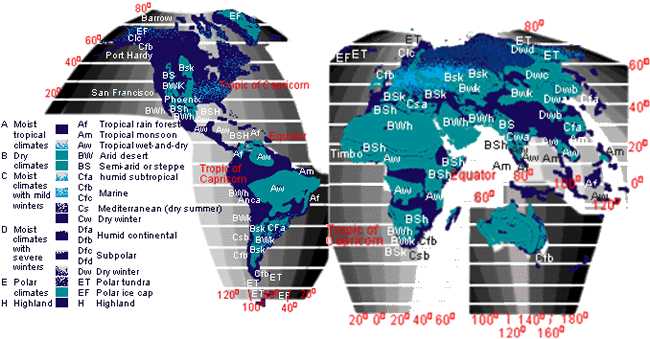
Figure 4
Global Temperatures
|
|
|---|
Note how the isotherms tend to bend along coastlines. This is due to the unequal heating of land and water and the tendency of the winds to blow along coastlines. Also of significance are the ocean currents and the upwelling of cold deep ocean waters. Examples of ocean currents include the California Current which flows southwards along the Californian coast and the Gulf Stream which flows northwards in the Atlantic.
Global Precipitation
Figure 7 summarizes the modern global mean precipitation climate record. Notice the high degree of regional variability.
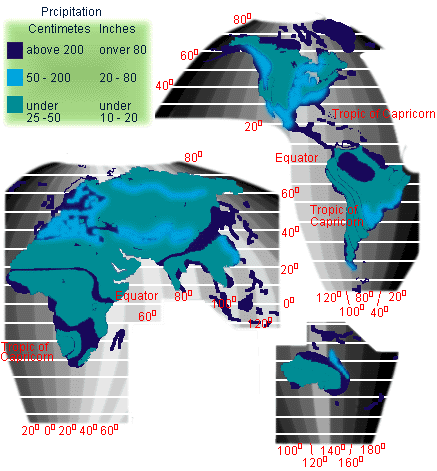
Figure 7. Global patterns of precipitation are closely tied to general
circulation and topographic changes
Current TrendsThe global average surface temperature has increased by 0.6 ±0.2°C since the late 19th century (IPCC, 2001). It is very likely that the 1990s was the warmest decade and 1998 the warmest year in the instrumental record since 1861 (see Figure 8). As indicated in Figure 8, most of the increase in global temperature since the late 19th century has occurred in two distinct periods: 1910 to 1945 and since 1976. The rate of increase of temperature for both periods is about 0.15°C/decade. Recent warming has been greater over land compared to oceans; the increase in sea surface temperature over the period 1950 to 1993 is about half that of the mean land-surface air temperature. The high global temperature associated with the 1997 to 1998 El Niño event stands out as an extreme event, even taking into account the recent rate of warming. |
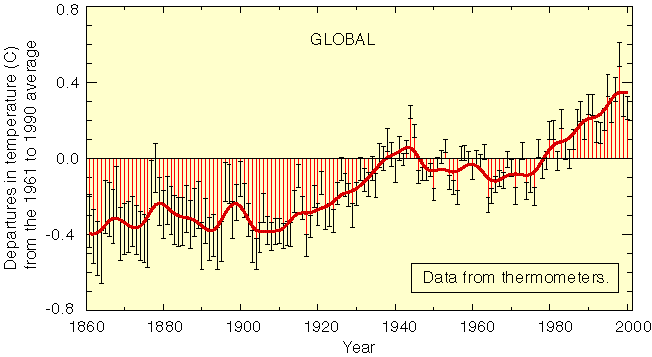 |
|
It also appears that the spatial patterns of warming that occurred in the early part of the 20th century were different than those that occurred in the latter part. Figure 9 shows the regional patterns of the warming that have occurred over the full 20th century, as well as for three component time periods. The most recent period of warming (1976 to 1999) has been almost global, but the largest increases in temperature have occurred over the mid- and high latitudes of the continents in the Northern Hemisphere. Year-round cooling is evident in the northwestern North Atlantic and the central North Pacific Oceans, but the North Atlantic cooling trend has recently reversed.
| | 1901-2000
| | 1910-1945 | 1946-1975 | 1976-2000 | |
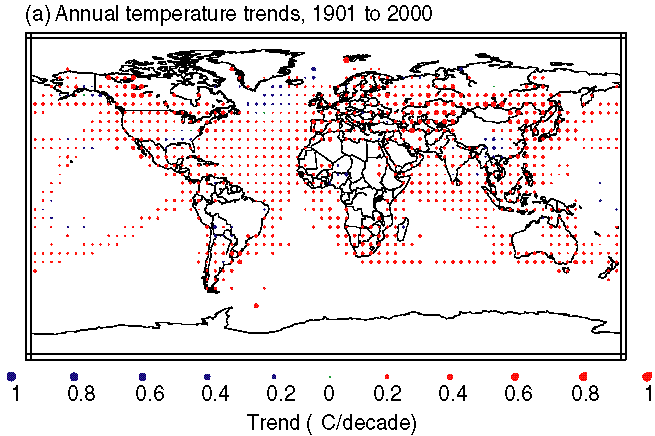 |
| Figure 9. Temperature trends for the periods 1901-1999, 1910-1945, 1946-1975 and 1976-1999. Trends are represented by the area of the circle with red representing increases, blue representing decreases, and green little or no change. [From IPCC, 2001] |
4. Summary
- The Earth's climate has changed dramatically in the past, apparently
in response to natural changes in orbital characteristics and topography.
- We are able to deduce past climates through multiple techniques but
much of the progress in resolving Cenozoic climate change has resulted
from oxygen and carbon isotope records.
- The climate of the Earth today varies by latitude and, to a lesser degree, longitude and is controlled by varying solar radiation availability and the redistribution of energy through wind and currents.
Take the Self-Test for this lecture.
(link to self-test will be added soon after lecture)
